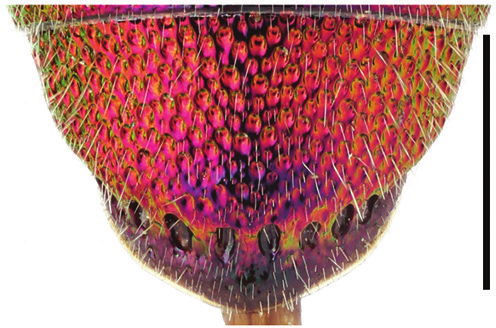Chrysis succincta
- Innhold
- Diagnosis
- Distribution
- Biology
Diagnosis
Figure 77
T3, dorsal view: Chrysis succincta ♀. Scale 1 mm.
Length 4–8 mm.
The species can be differentiated from other Nordic and Baltic species of the C. succincta group by having a rounded or slightly pointed, edentate posterior margin of T3 (Fig. 77) and a blue mesoscutellum. In C. leachii, the posterior margin of T3 is also edentate, but the mesoscutellum is mostly red. The scapal basin is largely shiny, without cross-ridging in the female, and mostly densely microsculptured in the male, with only a narrow central dull longitudinal line. The head, most of the mesosoma, base of T1 and the apical rim are green or blue, whereas the anterior margin of the pronotum and the mesoscutum are red in the female and golden green in the male. The metasoma is dorsally mainly red, or often greenish in the male.
Distribution
Denmark, Latvia, Lithuania. Rare.
Trans-Palearctic: Europe, northern Africa, Russian Far East (Linsenmaier 1997, Kurzenko and Lelej 2007). (In northern Africa represented by ssp. succinctula Linsenmaier, 1959).
Be aware that the records present in the GBIF map may be misleading for some countries due to unrevised data sets or missing information.
GBIF Taxon: Chrysis succincta Linnaeus, 1767Biology
Habitat: sparsely vegetated sandy areas. In central Europe typical habitats include e.g. embankments, wastelands and margins of pine forests (Trautmann 1930, Ressl 1973, Molitor 1935). Adults occasionally visit flowers of Apiaceae, Asteraceae and Euphorbiaceae (Molitor 1935, Linsenmaier 1997).
Flight period: mid-June to mid-August.
Host: unknown.
